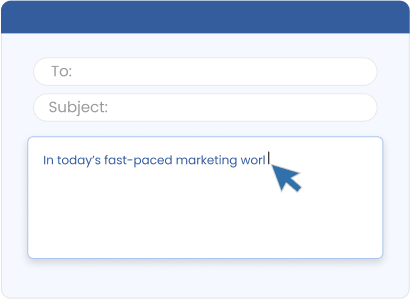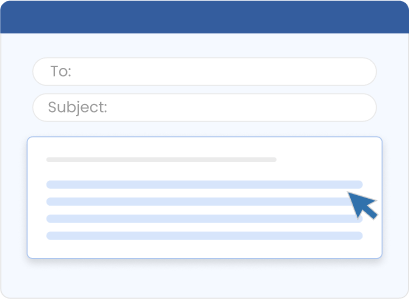Successful sales emails combine psychology, marketing savvy, and a deep understanding of your audience’s needs and desires. It’s about crafting a message that resonates personally, making each recipient feel like you’re speaking directly to them. This post is your roadmap to creating sales and prospecting emails that get opened and acted upon.
From the nuances of tone and language to the strategic structuring of your message, every element is a piece of the puzzle in the grand scheme of sales success.
Let’s transform your email approach into a powerful tool for business growth

Understanding Your Audience: The First Step to Success
Knowing who you’re talking to is not just a part of the process; it’s the foundation upon which successful email strategies are built. Let’s dive into how you can identify and understand your target demographic, tailor your message to their needs, and use market research to refine your approach.
Identifying Your Target Demographic
- Start with Data: Look at your existing customer base. What common characteristics do they share? Age, location, job title, and industry can all be starting points.
- Create Buyer Personas: Develop detailed profiles of your ideal customers. What are their goals, challenges, and interests? This step helps in visualizing the audience as real people with specific needs.
Tailoring Your Message to Meet Their Needs and Pain Points
- Speak Their Language: Use the language and jargon that resonates with your audience. A message for tech-savvy professionals should read differently than one for creative artists.
- Address Specific Pain Points: Show that you understand their challenges and offer solutions. Your product or service should come across as a remedy to their specific problems.
- Emphasize Benefits, Not Features: Focus on how your product or service can improve their life or work. It’s about the value you bring to them, not just the specifications of what you’re selling.
The Role of Market Research in Crafting Your Email
- Conduct Surveys and Polls: Direct feedback from potential or current customers can provide invaluable insights.
- Monitor Social Media and Forums: These platforms are goldmines for understanding what your audience is talking about, their concerns, and their desires.
- Analyze Competitors: See how similar businesses are communicating with the same audience. What can you learn from their successes and failures?

Crafting a Compelling Subject Line
The subject line of your sales email is the gatekeeper to your message. It’s the first thing your recipient sees, and in a world where inboxes are flooded daily, it’s your one shot at making a memorable first impression. Let’s explore the art of creating subject lines that capture attention and entice the reader to open your email.
The Power of First Impressions: Why Subject Lines Matter
- A Make-or-Break Moment: Your subject line determines whether your email gets opened or lost in the abyss of the unread or deleted.
- Sets the Tone: It gives a sneak peek into the content of your email, setting expectations right from the get-go.
- Differentiation is Key: A unique subject line can make your email stand out in a sea of generic messages.
Tips for Creating Attention-Grabbing Subject Lines
- Keep It Short and Sweet: Aim for subject lines that are concise yet powerful. Remember, many people read emails on mobile devices, so brevity is crucial.
- Invoke Curiosity: Pique the reader’s interest without giving everything away. Tease them with hints of what’s inside.
- Personalization Works Wonders: Use the recipient’s name or reference something relevant to them. This personal touch can significantly increase open rates.
- Be Clear, Not Clickbaity: While being intriguing is good, misleading subject lines can harm trust and sender reputation.
- Test and Refine: Use A/B testing to see what resonates best with your audience. Continuous testing leads to continuous improvement.
Examples of Effective Subject Lines
“John, Your Custom Plan is Ready!”
- Personalized and implies that something has been specifically created for the recipient.
“3 Proven Strategies to Amplify Your Sales”
- Offers clear value and hints at exclusive insights inside
“Is This the Biggest Mistake Your Team is Making?”
- Provokes thought and curiosity about common pitfalls they might be facing
“Last Chance: Exclusive Offer Ends Today!”
- Creates a sense of urgency and exclusivity

The Opening Line: Hooking Your Reader
Once your subject line has successfully enticed a reader to open your email, the next crucial step is the opening line. This is where you either hook your reader or lose them. A strong opening line sets the stage for the rest of your message, so let’s delve into how to make those first few words count.
Importance of a Strong Opening
- First Impressions Last: The opening line is your first opportunity to engage the reader. A weak start can mean your email gets skimmed over or, worse, deleted.
- Builds Connection: A good opening line resonates with the reader, making them feel understood and interested.
- Sets the Tone: It establishes the voice and style of your email, whether it’s professional, friendly, informative, or persuasive.
Strategies for Engaging the Reader Immediately
- Start with Relevance: Address something that is top-of-mind for your reader. This could be a recent industry development, a common challenge, or a shared interest.
- Use a Personal Touch: Reference something specific to the recipient, such as a previous interaction or a mutual connection.
- Ask a Thought-Provoking Question: Pose a question that relates to their needs or challenges, encouraging them to think and engage.
- Lead with a Compelling Fact or Statistic: Use a surprising or relevant fact that sets the stage for your message.
- Be Concise and Direct: Get to the point quickly. Long-winded openings can lose the reader’s attention.
Examples of Effective Opening Lines
“Did you know that 70% of businesses see a return on investment with email marketing?”
- Starts with a compelling statistic that highlights the value of what you’re offering
“Last time we spoke, you mentioned how time-consuming your current project management process is…”
- Personalized and shows you’re paying attention to their specific needs
“What if I told you there’s a way to triple your leads without increasing your marketing budget?”
- Poses a provocative question that addresses a common desire
“In today’s fast-paced marketing world, staying ahead of the curve is more challenging than ever…”
- Relates to a current industry trend, making it immediately relevant

The Body: Delivering Your Message
Your sales email’s body is where your storytelling skills come into play. It is the meat of your message, where you balance information with persuasion, and where your product or service takes center stage.
By following these strategies, you can craft the body of your sales email in a way that informs, persuades, and connects with your reader on a deeper level.
Structuring Your Email for Maximum Impact
- Start with a Clear Objective: Know what action you want the reader to take and build your content around it.
- Organize Your Points Logically: Present your information in a way that’s easy to follow. Start with the most important points and use bullet points or short paragraphs for clarity.
- Keep It Concise: Avoid overwhelming the reader. Stick to the essentials and keep your sentences short and to the point.
Balancing Information with Persuasion
- Educate Your Reader: Provide valuable information that positions you as an authority. This builds trust and credibility.
- Use Persuasive Language: Choose words that motivate action but avoid being overly salesy. Phrases like “unlock potential,” “transform your workflow,” or “achieve results” can be effective.
- Call to Action (CTA): End with a clear CTA. Whether it’s to schedule a call, visit a website, or try a demo, make sure it’s direct and easy to follow.
Using Storytelling to Connect with the Reader
- Share Relatable Scenarios: Use stories or scenarios in which the reader can see themselves. This helps them visualize the benefits of your offering.
- Incorporate Emotion: Emotional connections can be powerful. Whether it’s the relief of solving a problem or the excitement of achieving goals, tap into these feelings.
Highlighting Benefits Over Features
- Focus on Solutions: Instead of listing features, explain how your product or service solves specific problems or improves situations.
- Use Customer Testimonials and Success Stories: Real-life examples and endorsements can be highly persuasive. They provide social proof and demonstrate the value of your offering.
Visual Elements and Formatting
- Enhance with Visuals: Images, infographics, or videos can break up text and make your email more engaging. Ensure they are relevant and add value.
- Best Practices for Email Formatting:
- Readable Font and Size: Choose a font that’s easy to read on both desktop and mobile devices.
- Use White Space: Avoid clutter. Ample white space makes your email easier to read.
- Mobile-Friendly Design: With many users checking emails on mobile, ensure your email looks good on smaller screens.

The Call-to-Action: What’s Next?
A well-crafted call-to-action (CTA) can significantly increase your chances of converting a reader into a lead or customer, particularly if it encapsulates the essence of your message and the value of your offer, all while guiding the reader toward a clear, actionable next step.
By crafting your CTA with clarity, value, and a touch of urgency, you can encourage your readers to take action in a way that feels natural and unforced.
The Importance of a Clear, Compelling CTA
- Directs the Reader: A CTA serves as a signpost, telling the reader exactly what to do next. Without it, even the most engaging email can fall flat.
- Increases Conversion Rates: A compelling CTA can transform passive readers into active participants, directly impacting conversion rates.
- Clarifies the Offer: It reiterates what’s in it for the reader, reinforcing the value proposition of your message.
Examples of Effective CTAs
- “Claim Your Free Trial” – Offers a low-risk way to experience your product or service.
- “Schedule Your Consultation Today” – Positions the next step as a personalized, value-added opportunity.
- “Download Your Free Guide” – Provides immediate value, appealing to those looking for resources or information.
- “Join Our Exclusive Webinar” – Invites readers to an event, offering information and interaction.
How to Encourage a Response Without Being Pushy
- Create a Sense of Urgency: Use language that suggests limited availability or a time-bound offer, such as “Limited spots available” or “Offer ends soon.”
- Emphasize Value, Not Just Action: Make sure your CTA highlights the benefit of taking action. It’s not just about what they need to do but what they gain from doing it.
- Offer Choices: Sometimes, providing a secondary, less committed option can be effective. For example, “Start your trial” or “Learn more.”
- Use Persuasive, Not Aggressive Language: Phrases like “Don’t miss out” or “Discover how” are persuasive without being forceful.
- Follow-Up Tactfully: If you plan to send a follow-up email, mention it subtly. This keeps the door open without pressure.
Following Up: The Key to Closing the Deal
Understanding the nuances of follow-up emails – from timing to content – can significantly increase your chances of converting prospects into customers.
Let’s explore the best practices for following up effectively.
Timing and Frequency of Follow-Up Emails
- The Initial Follow-Up: The first follow-up should ideally be sent within 48 hours of your initial email. This keeps your message fresh in the prospect’s mind.
- Establish a Rhythm: Don’t bombard your prospect with daily emails. A good rule of thumb is to wait a few days to a week between follow-ups.
- Be Mindful of Signals: If a prospect engages with your emails (like opening them or clicking on links), it’s a sign to continue. If there’s no engagement, consider spacing out your follow-ups more.
Crafting Follow-Up Messages That Get Responses
- Add New Value: Each follow-up should offer something new. This could be additional information, a special offer, or a fascinating insight.
- Keep It Short and Focused: Respect your prospect’s time. Get straight to the point and make your intention clear.
- Personalize Your Approach: Reference previous interactions and show that you’re paying attention to their needs and interests.
- End with a Clear Call-to-Action: Like your initial email, end with a CTA that guides them towards the next step.
When to Move On from a Prospect
- No Response After Multiple Attempts: If you’ve sent several follow-ups (typically around 4-6) without any response, it might be time to back off.
- Listen to Their Words: If a prospect explicitly requests no further contact or shows disinterest, respect their wishes.
- Focus on Quality, Not Quantity: It’s more productive to focus on prospects who show some level of engagement than to chase those who are consistently unresponsive.
- Keep the door Open: Even if you decide to stop active follow-up, leave the conversation on a positive note. Circumstances can change, and they might become a viable lead in the future.

Measuring Success: Email Metrics to Monitor
By keeping a close eye on these metrics and continuously refining your approach based on data, you can turn your sales email strategy into a well-oiled machine:
- Open Rate: This metric indicates how many people are opening your emails. A low open rate could suggest issues with your subject lines or sender reputation.
- Click-Through Rate (CTR): This measures how many recipients clicked on links within your email. It’s a strong indicator of how engaging your content and offers are.
- Conversion Rate: The percentage of recipients who took the desired action (like making a purchase or signing up for a webinar) after clicking a link in your email.
- Bounce Rate: Tracks the percentage of emails that couldn’t be delivered. High bounce rates may signal problems with your email list quality.
- Unsubscribe Rate: How many people opted out of your email list after receiving your email. Having some unsubscribes is normal, but a high rate can be a red flag.
Tools and Techniques for Tracking Email Performance
- Email Marketing Software: Platforms like Retreva, Mailchimp, Constant Contact, or HubSpot offer built-in analytics to track these KPIs.
- A/B Testing: Test different elements of your emails (like subject lines, content, and CTAs) to see what resonates best with your audience.
- Segmentation: Break down your email data by demographics or behaviors for more detailed insights.
- Integration with CRM: Linking your email platform with a Customer Relationship Management (CRM) system can provide deeper insights into how email interactions translate into sales.
Using Data to Refine Your Approach
- Analyze and Adapt: Regularly review your email metrics. Look for trends and patterns that can inform your future strategies.
- Personalization: Use data to understand your audience better and tailor your emails more effectively to different segments.
- Optimize Send Times: Experiment with different sending times and days to find when your audience is most likely to engage.
- Content Relevance: Use engagement data to refine the topics and types of content that resonate most with your audience.
Wrapping Up
Knowing the anatomy of a successful sales email can be a game-changer for any business looking to enhance its communication strategy. From crafting compelling subject lines to engaging content and persuasive CTAs, each element plays a crucial role in converting prospects into loyal customers.
Reach out to us for expert guidance and support –– together, we can craft sales emails that not only get opened but also deliver results.


